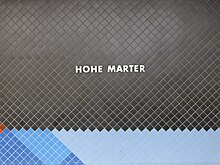Hohe Marter underground station
The Hohe Marter underground station (abbreviation: HM ) is the 27th underground station of the Nuremberg underground and was opened on September 27, 1986. It is used by around 8,800 passengers every day.
The name given to the Hohe Marter is a torture column on Schweinauer Hauptstrasse, which marked the former escort border between the imperial city of Nuremberg and the margraviate of Ansbach . A short street east of Bundesstraße 2 is named after her. The name was later transferred to the southwestern area of the Nuremberg district of Schweinau .
location
The Hohe Marter underground station is 1,317 meters north of the Röthenbach underground station . After crossing under the Main-Danube Canal 900 m south , an x-shaped double track change follows in the direction of Ziegelstein before the Schweinau underground station follows 684 m north . The station is located in the Schweinau district of Nuremberg and extends underground in a north-south direction under Schweinauer Hauptstraße (B2) between Gustav-Adolf- / Nopitschstraße and Adalbertstraße. Ramps lead from both platform heads to a distribution floor. The northern distribution floor has stairs to all corners of the intersection of Schweinauer Haupt- / Gustav-Adolf- / Nopitschstraße, the southern distribution floor has a staircase each to Adalbert- and Schweinauer Hauptstraße as well as two ramps to Rottweiler Straße and the adjacent park.
The Nuremberg TV tower is located 600 m south of the train station .
Building and architecture
The station structure is 268 m long, 15 m wide and 7.2 m deep. Construction work began on February 14, 1984 and was carried out using the cut-and-cover method. The platform accesses were designed as ramps with a maximum gradient of 8% so that they are handicapped accessible. Access to the station is also possible via elevators.
A competition was announced for the station design, which the Nuremberg artist Peter Angermann won. A 1:10 drawing of the Nuremberg TV tower he made was realized as a wall mosaic in day and night display, for which approx. 120,000 ceramic tiles in the format 9.5 × 9.5 cm in 30 different colors were attached to the platform walls . Another special feature is that the television towers always point in the direction of travel and it was the first Nuremberg underground station without central supports.
Lines
| line | course |
|---|---|
|
|
Röthenbach - Hohe Marter - Schweinau - St. Leonhard - Rothenburger Straße - Plärrer - Opera House - Central Station - Wöhrder Wiese - Rathenauplatz - Rennweg - Schoppershof - Nordostbahnhof - Herrnhütte - Ziegelstein - Airport |
The station is served by the U2 underground line. On the surface there are the stops Hohe Marter Nord and Hohe Marter Süd , which are served by the city bus lines 35 and 65 , as well as by the private bus line 713 . The N7 night bus also runs on weekends .
literature
- City of Nuremberg / Building Department (Ed.): U-Bahn Nuremberg 10 . Press and Information Office of the City of Nuremberg, Nuremberg 1986.
- Michael Schedel: Nuremberg U-Bahn Album . Robert Schwandl Verlag, Berlin 2007, ISBN 3-936573-11-5 .
Web links
- Local area map on the sides of the VGN (PDF; 93.52 KB)
- Station description on local traffic Franconia (private)
- Station pictures on cityverkehr.de (private)
Individual evidence
- ↑ Overview: These are the most used underground stations in Nuremberg on nordbayern.de, from December 27, 2019, accessed on January 6, 2020
Coordinates: 49 ° 25 ′ 45 ″ N , 11 ° 2 ′ 39 ″ E








